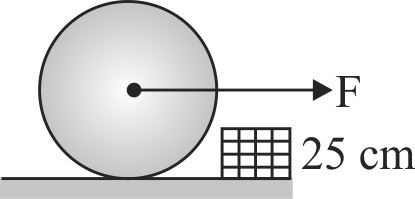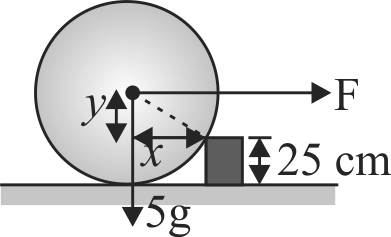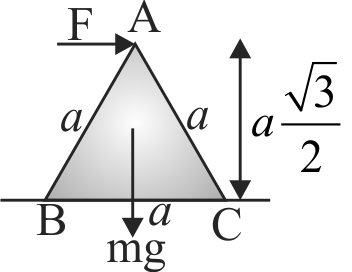366221
A vertical disc of mass \(5\;kg\) and radius \(50\;cm\) rests against a step of height \(25\;cm\) as shown in the figure. What minimum horizontal force applied perpendicular to the axle will make the disc to climb the step? Take \(g = 10\;m/{s^2}\).
366222
A cubical block of side \(L\) rests on a rough horizontal surface with coefficient of friction \(\mu\). A horizontal force \(\mathrm{F}\) is applied on the block as shown in the figure. If the coefficient of friction is sufficiently high so that the block does not slide before toppling, the minimum force required to topple the block is
366223
An equilateral prism of mass \(m\) rests on a rough horizontal surface with coefficient of friction \(\mu\). A horizontal force \(\mathrm{F}\) is applied on the prism as shown in the figure. If the coefficient of friction is sufficiently high so that the prism does not slide before toppling, the minimum force required to topple the prism is
366221
A vertical disc of mass \(5\;kg\) and radius \(50\;cm\) rests against a step of height \(25\;cm\) as shown in the figure. What minimum horizontal force applied perpendicular to the axle will make the disc to climb the step? Take \(g = 10\;m/{s^2}\).
366222
A cubical block of side \(L\) rests on a rough horizontal surface with coefficient of friction \(\mu\). A horizontal force \(\mathrm{F}\) is applied on the block as shown in the figure. If the coefficient of friction is sufficiently high so that the block does not slide before toppling, the minimum force required to topple the block is
366223
An equilateral prism of mass \(m\) rests on a rough horizontal surface with coefficient of friction \(\mu\). A horizontal force \(\mathrm{F}\) is applied on the prism as shown in the figure. If the coefficient of friction is sufficiently high so that the prism does not slide before toppling, the minimum force required to topple the prism is
366221
A vertical disc of mass \(5\;kg\) and radius \(50\;cm\) rests against a step of height \(25\;cm\) as shown in the figure. What minimum horizontal force applied perpendicular to the axle will make the disc to climb the step? Take \(g = 10\;m/{s^2}\).
366222
A cubical block of side \(L\) rests on a rough horizontal surface with coefficient of friction \(\mu\). A horizontal force \(\mathrm{F}\) is applied on the block as shown in the figure. If the coefficient of friction is sufficiently high so that the block does not slide before toppling, the minimum force required to topple the block is
366223
An equilateral prism of mass \(m\) rests on a rough horizontal surface with coefficient of friction \(\mu\). A horizontal force \(\mathrm{F}\) is applied on the prism as shown in the figure. If the coefficient of friction is sufficiently high so that the prism does not slide before toppling, the minimum force required to topple the prism is

